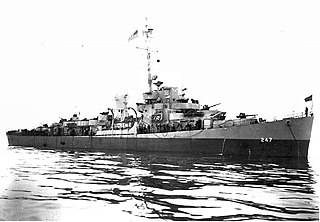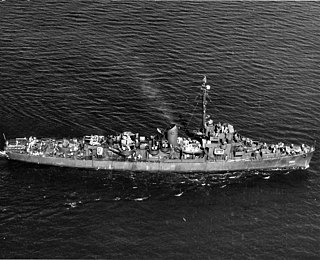
USS Evarts (DE-5) was the lead ship of her class of destroyer escorts in the United States Navy.

USS Sutton (DE-771) was a Cannon-class destroyer escort in service with the United States Navy from 1943 to 1948. In 1956, she was transferred to South Korea, where she served as Kang Won (F-72) until 1977. The ship was then cannibalized for spare parts in the Philippines.

USS Breeman (DE-104) was a Cannon class destroyer escort in service with the United States Navy from 1943 to 1946. In 1948, she was sold to Taiwan, where she served as Taihu (太湖) until 1972.

USS Amesbury (DE-66/APD-46), a Buckley-class destroyer escort of the United States Navy, was named in honor of Lieutenant (jg) Stanton Morgan Amesbury (1916–1942), who was killed in action while flying from the aircraft carrier Ranger (CV-4) during Operation Torch in 1942.

USS Spangenberg (DE/DER-223), a Buckley-class destroyer escort of the United States Navy, was named in honor of Gunner's Mate Kenneth J. Spangenberg (1922-1942), who died as a result of wounds suffered during the Naval Battle of Guadalcanal, while serving aboard the heavy cruiser San Francisco (CA-38). He was posthumously awarded the Navy Cross.

USS Ahrens (DE-575), a Buckley-class destroyer escort of the United States Navy, was named in honor of Private Edward H. Ahrens (1919–1942), who was killed during the Battle of Tulagi and Gavutu–Tanambogo on 8 August 1942. He was posthumously awarded a Navy Cross.

USS Bebas (DE-10) was an Evarts-class destroyer escort in the service of the United States Navy from 1943 to 1945.

USS Willis (DE–395) was an Edsall-class destroyer escort of the United States Navy.

USS Brennan (DE-13) was an Evarts-class destroyer escort constructed for the United States Navy during World War II and commissioned in January 1943. She performed anti-submarine and anti-aircraft convoy protection duties in North Atlantic Ocean waters, and was decommissioned in October 1945 at New York Navy Yard and scrapped in 1946.

USS Leopold (DE-319) was an Edsall-class destroyer escort built for the United States Navy during World War II. Named for Ensign Robert Lawrence Leopold to date it is the only U.S. Naval vessel to bear the name.

USS Sederstrom (DE-31) was a Evarts-class destroyer escort of the United States Navy during World War II. She was promptly sent to the Pacific Ocean to escort convoys and to protect other ships from Japanese planes and submarines. Her assignments took her from one battle area to another, but she was fortunate in remaining almost unscathed by the end of the war. For her efforts in battle areas, she was awarded five battle stars by war's end.

USS O'Toole (DE-527) was an Evarts-class destroyer escort of the United States Navy during World War II. She served in the North Atlantic ocean protecting convoys and other ships from German U-boats and aircraft. She also performed escort and anti-submarine operations before returning home at the end of the conflict.

USS Amick (DE-168) was a Cannon-class destroyer escort built for the United States Navy during World War II. She served in the Atlantic Ocean and then the Pacific Ocean and provided escort service against submarine and air attack for Navy vessels and convoys.

USS Baker (DE-190) was a Cannon-class destroyer escort built for the United States Navy during World War II. She served in the Atlantic Ocean and provided escort service against submarine and air attack for Navy vessels and convoys. She returned home at war's end with a one battle star for her assistance in sinking a German submarine.

USS Wingfield (DE-194) was a Cannon-class destroyer escort built for the United States Navy during World War II. She served in the Atlantic Ocean and Pacific Ocean and provided escort service against submarine and air attack for Navy vessels and convoys.

USS Tomich (DE-242) was an Edsall-class destroyer escort in service with the United States Navy from 1943 to 1946. She was scrapped in 1974.

USS Stanton (DE-247) was an Edsall-class destroyer escort built for the U.S. Navy during World War II. She served in the Atlantic Ocean the Pacific Ocean and provided destroyer escort protection against submarine and air attack for Navy vessels and convoys.

USS Sellstrom (DE-255) was an Edsall-class destroyer escort built for the U.S. Navy during World War II. She served in the Atlantic Ocean, the Pacific Ocean and provided destroyer escort protection against submarine and air attack for Navy vessels and convoys.

USS Rhodes (DE-384) was an Edsall-class destroyer escort in service with the United States Navy from 1944 to 1946 and from 1955 to 1963. She was scrapped in 1975.

USS Swenning (DE-394) was an Edsall-class destroyer escort in service with the United States Navy from 1943 to 1946. She was sold for scrapping in 1974.




















